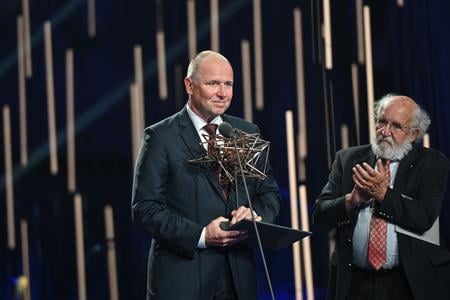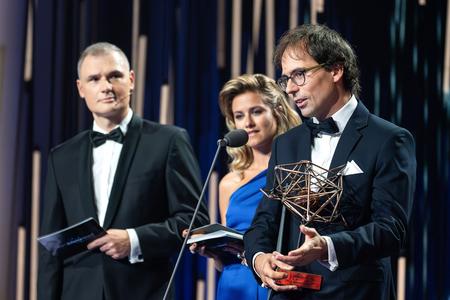The film Rain Man, a 1988 road drama, tells the story of a selfish wheeler-dealer named Charlie Babbitt, who finds out that his father's estate has been bequeathed to his brother Raymond, whose existence he had previously been unaware of. Raymond is an autistic savant; he has eidetic memory, which he is able to make use of in a casino, among other things.
The movie is credited with increasing awareness of autism.
This article is supported by the ESET Foundation, whose annual ESET Science Award recognises exceptional scientists.
"It must be said that Rain Man is a very old film. I think it was more about sensitising us to life with people who previously stood outside of society. In this respect, it is very good and fulfilled its role," says Daniela Ostatníková, the winner of this year's ESET Science Award in the Outstanding Academic in Slovakia category. She is the head of the Institute of Physiology and Vice-Dean for International Relations of the Faculty of Medicine of Comenius University Bratislava.
On the other hand, the movie is somewhat misleading, and has resulted in autism being widely associated, in the popular imagination, with superhuman intelligence.
"Autism is a very heterogeneous disorder, which is why we prefer to talk about autism spectrum disorder. In other words, autistic individuals are not uniform at all," Ostatníková explains, adding that there are those who talk a lot and those who do not speak at all. Some have intellectual disabilities; others do not.

To stay up to date with what scientists in Slovakia or Slovak scientists around the world are doing, subscribe to the Slovak Science newsletter, which will be sent to readers free of charge four times a year.
Three characteristics
When autism is diagnosed, three basic characteristics are considered: deficits in social communication and interaction; altered perception of reality compared to the general population; and the tendency to engage in repetitive patterns of behaviour.
As for the first one, autistic individuals avoid looking into other people’s eyes, and don't like it when another person approaches them and requires interaction. Autistic people have perceptual disorders, which means that they cannot differentiate between important perceptions and those that are noise. This can lead to them being agitated when, for example, someone speaks, a phone rings, a washing machine is running, a radio playing, and a siren can be heard outside all at the same time. In such situations, they might have to cover their ears with their hands. Lastly, stereotypes such as following the same route to work, eating the same food or wearing the same clothes bring them relief, allowing them to focus on other things.
"Their brain is very systematised, but not empathised," says Ostatníková, adding that by empathy she means the ability to put oneself into the shoes of another person. However, autistic people seem to have a different form of empathy.
"There have been papers showing that when two autistic individuals talk, their communication is as if it were 'normal' – i.e. they understand each other. When two neuro-typical people talk, they also understand one other. But the two groups have problems understanding each other. Empathy, understanding, and communication interaction apparently exist in the sense of being more oriented towards reality, facts, and systems that can be predicted. They cannot navigate the unpredictable," she explains, adding that autistic traits are commonly accompanied by technical talent in mathematics, physics and technology; in short, with subjects that are congruent with systemisation of the brain.

Seeing the forest for the trees
Ostatníková thinks that some functions of a person's brain are boosted, while other parts of the body are lacking. She has worked with intellectually gifted children who did not excel in motor skills. There are also autistic people whose intellect can be considered normal, but when it comes to socialisation and communication, they understand everything literally, missing undertones, humour and metaphors. You might remember the character Sheldon Cooper from the TV series The Big Bang Theory. Although it was not the intention of the show’s creators, the character had many traits that fall under the diagnosis of Asperger's syndrome. As such, he often did not understand sarcasm and other forms of witty humour, leading to many a funny situation. However, over the course of the series, Sheldon learns to spot sarcasm to a certain extent. According to Ostatníková, this phenomenon actually occurs.
"Thanks to their intellect, [autistic individuals] can learn certain strategies that help them in social interactions. But it's not their own feeling; it's learned," she explains.
Then there are individuals, so-called savants, who are exceptional in a particular domain. Science cannot yet explain where these abilities come from. One well-known example involves an adopted boy from Great Britain who could hardly move and did not speak. One day, his mother heard someone playing the piano. To her surprise, she found it was her son – even though he had never had any formal training in music.
We know that the autistic brain develops differently than the brains of neurotypical people, as a result of the interplay of genes and the environment. In prenatal life, genes determine how neurons will be formed and which part of the brain they will connect to are turned on. These parts are therefore prepared in advance for a certain function. For example, some neurons know to migrate to the occipital lobe, the centre for vision. Visual stimuli are saturated by the environment, gradually creating the neural networks necessary to understand what we see, and to remember it. When you hold an apple in your hand, you know that it is not a ball, but you also recognise its taste, colour and shape.
The problem for most autistic individuals is that these networks are more developed than they should be. This causes them to have a tremendous ability to focus on detail.
We also have an overabundance of neurons and connections in the early years of life. As we learn, the most appropriate ones are strengthened. Those that are not are eliminated in favour of specialisation, which happens roughly until puberty. Around then, the possibility to develop new talents also fades. If, for example, someone has a disposition for playing the piano, but does not develop it before puberty, it is more difficult from that point on to learn.
This elimination is more difficult for autistic individuals. Although, for example, their sight is capable of incredible discrimination, it is paradoxically more difficult for them to understand what it actually means. Figuratively speaking, they cannot see the forest for the trees.
The causes are still being researched
There is no single gene responsible for autism. More than 100 genes, known as pleiotropic genes, are suspected of being involved. In addition to autism, in tandem with others they play a role in ADHD, for example. Autistic people usually also suffer from other disorders, such as depression, anxiety and epilepsy, and can have obsessive compulsive characteristics.
That's why it's difficult to research autism. Taking blood and examining one marker for the purposes of diagnosis, for example, is not possible.
Among people with autism, there are more boys than girls. This is probably partly due to the fact that the tests were originally developed for the former. The reason was that basic characteristics such as repetitive behaviour are more pronounced in boys. Ostatníková says that girls know how to “camouflage it”. In general, girls are more empathetic, have more female sex hormones and also have higher concentrations of oxytocin. According to the scientist, these are prosocial factors that seem to weaken the autism phenotype a little.
"These hormonal sex differences are thought to be one of the reasons why autism is more common in boys," she says. Today, however, research is oriented so that we can detect it in girls, and thus find out whether the proportion currently observed – of 4 boys to 1 girl – still holds. In the highly functional form, the ratio is even more skewed, at 10 to 1. It is also interesting that girls with autism seem to have more masculine face morphology.
Ostatníková says that 10 to 15 years ago, the concept of autism was quite novel in Slovakia. At that time, there were only a few non-governmental organizations and centres founded by parents, because there was no other help (it still remains difficult to come by). In 2013, she founded the Academic Research Center for Autism, in order to explain to the professional and lay public alike what autism is all about.
"People learned what it is, allowing them to observe the characteristics in their children. Consequently, there was more interest in diagnosis, because there was awareness. Maybe it is also because we are demystifying psychiatric diseases, which is a very good and right thing to do, and people are not ashamed any more," she says.
This is also why it may seem that cases of autism are increasing: although affected people have always been here, before they were hidden.
"On the other hand, it must be said that the number of children with neurodevelopmental disorders is generally increasing. An environment full of toxins also contributes to this. Among them are substances called endocrine disruptors, either man-made or natural chemicals that interfere with the body's hormones," she explains.
In addition, the age when people have children is shifting. According to Ostatníková, this means that the germ cells that merge into the zygote are exposed to these substances for a longer time. Thus, ‘de novo’ mutations arise, meaning that if something happens in these cells the mutations will be passed on to the child, who may develop autism even if neither parent is carrying the mutation of the candidate gene. It's a little bit of a paradox. It was found that the older men are, and vice versa, the younger women are, the higher the possibility of having child with autism. It has also been found that 70 to 75 percent of autistic people have digestive disorders and that children with autism have different intestinal flora than children of the general population.

Unique people
Ostatníková says that autism is very difficult to understand from social, cultural and human perspectives, because non-autists cannot fully empathise with autistic individuals. But we have to prepare them for life in this society. There are practices that suppress the undesirable aspects of autism, and at the same time support the strong aspects.
For example, applied behavioural analysis is used, in which individuals with autism and their strengths and weaknesses are analysed. Subsequently and slowly, stimuli in the environment to which an individual is attuned are used in order to strengthen the positive aspects and eliminate undesirable ones such as self-harm or aggressive behaviour. It is not a question of forcibly changing an individual. However, it must be done very sensitively, and on a case-by-case basis.
"Our medics go to an intervention centre, where they sensitise children with autism to a doctor's examination. They come, get to know each other, put on a white coat so that the child does not consider such a person to be a threat. Then they come with a stethoscope, examine their chest, give it to them, to hear the heartbeat. The goal is that a parent will not have a problem when visiting the doctor or that their child will refuse medical help," explains Ostatníková.
"[Autistic people] are unique. When I studied intellectually gifted children, it seemed to me that they lived in another dimension, and we did not have access to it. They always lacked something, but their minds worked. What is right: to let their minds work like they are and maybe be unhappy, or to teach them to go for a beer and have fun with friends, if I put it like this? They may bring amazing discoveries into the world," says the scientist, adding that when she was young, people in wheelchairs were not visible: suddenly, when they were allowed to integrate, they showed that they had so much to contribute to society.
This article is supported by the ESET Foundation, whose annual ESET Science Award recognises exceptional scientists.


 Daniela Ostatníková. (source: ESET Science Award/Linda Kisková Bohušová)
Daniela Ostatníková. (source: ESET Science Award/Linda Kisková Bohušová)
 Daniela Ostatníková during the ESET Science Award ceremony. (source: ESET Science Award/Linda Kisková Bohušová)
Daniela Ostatníková during the ESET Science Award ceremony. (source: ESET Science Award/Linda Kisková Bohušová)